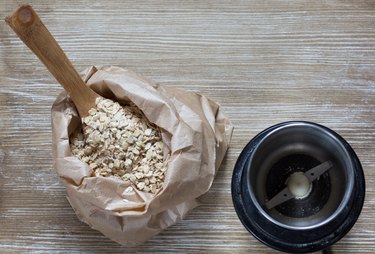
Whether you use cooked or raw oats in a smoothie, oats add fiber and minerals like magnesium and zinc, which boost the health benefits of your drink. Be sure to avoid pre-flavored packets of oatmeal, as they may include preservatives and added sugars.
Tip
You do not need to cook oats before adding them to a smoothie. Raw oats are safe and nutritious to eat. However, they have a rougher texture compared to softer cooked oats.
Video of the Day
Oatmeal in a Smoothie
Smoothies, with the right ingredients, make for a nutritious and filling meal or snack. Adding oatmeal not only adds extra nutrients, but it also adds both soluble and insoluble fiber. Insoluble fiber does not dissolve in water, but soluble fiber does, which causes it to thicken and make the smoothie more filling.
Video of the Day
Tip
The fiber in oats does more than fill you up. It also helps to lower your cholesterol, improve digestion, lower blood sugar and prevent heart disease, advises Kansas State University Research and Extension.
If you prefer cooked oatmeal in a smoothie, try this LIVESTRONG.com recipe:
- Cook 1 cup of oatmeal.
- Add the oatmeal to a blender with half of a Honeycrisp apple, half of a Bartlett pear, 1 cup of hemp milk, 1 teaspoon of maple syrup and a pinch of ground cinnamon.
- Blend ingredients until smooth.
You can use raw oats instead of cooked in smoothie recipes, but the texture will be different. To keep a smooth consistency in a smoothie with raw oats, try our Golden Smoothie recipe:
- Put 1/4 cup of raw rolled oats in a blender and process until finely ground.
- Add 1 cup of coconut water, two tangerines, 2 tablespoons of coconut milk, 1 teaspoon of honey, 1/4 teaspoon of vanilla extract and 1/2 teaspoon of ground turmeric to the blender.
- Blend ingredients until smooth.
Raw Oats Nutrition
Cooking oatmeal does not cause any significant change to the nutritional value of the oats as they are already processed to remove the hull and clean the oats. Cooking the oats in water does make them softer and more easily digestible, notes a study published in the June 2014 edition of the British Journal of Nutrition.
One cup of plain, cooked oatmeal contains 166 calories, according to the USDA. Two-thirds of those calories come from carbohydrates. The remaining calories are from fat and protein. In addition, oatmeal provides several key nutrients, including:
- 4 grams of fiber, which is 16 percent of the recommended daily value(DV)
- 5.0 grams of protein, which is 12 percent
of the recommended DV
2.1 milligrams of iron, which is 12 percent of the recommended DV
63.2 milligrams of magnesium, which is 15 percent of the recommended DV
2.3 milligrams of zinc, which is 21 percent of the recommended DV
Instant oatmeal may have less fiber and added sugar and salt when compared to other oats, advises Colorado State University Extension. This type of oatmeal is the most processed, which allows it to cook so quickly.
Rolled oats are rolled flat, steamed and then dried. Steel-cut oats are the least processed type of oat. Rather than being rolled and steamed, the oats are simply cut into two or three pieces. Using steel-cut oats in smoothies may result in a thicker and coarser smoothie than rolled oats, especially if you opt to not cook the oats.